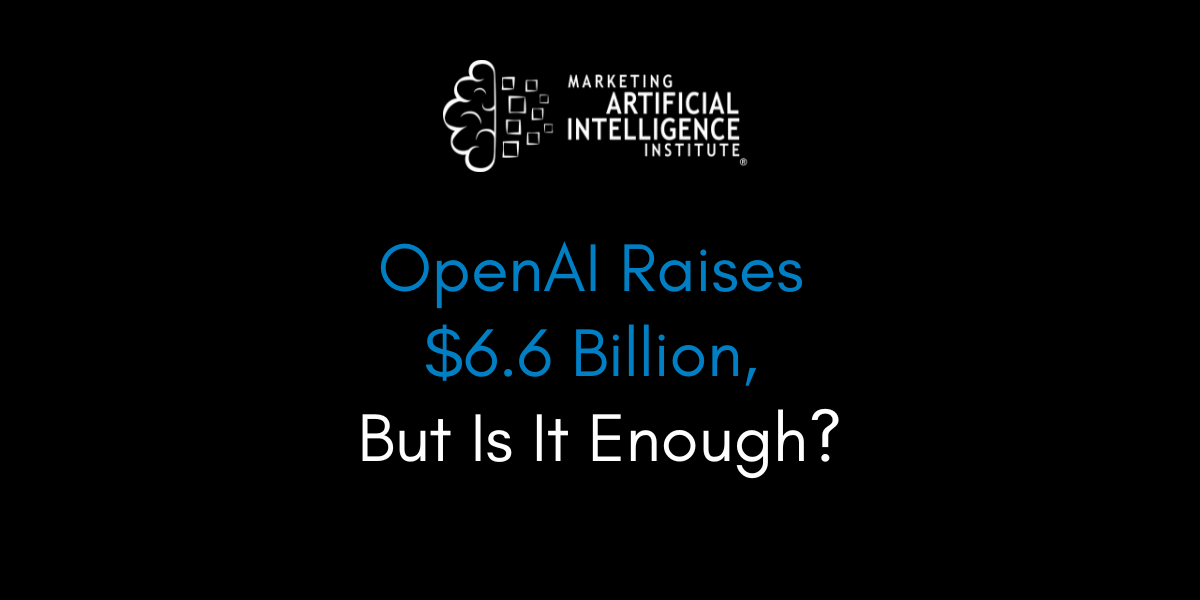OpenAI just secured a massive $6.6 billion funding round, valuing the company at a staggering $157 billion (nearly double OpenAI’s previous valuation of $80 billion).
The round was led by Thrive Capital, with participation from Microsoft and Nvidia. The funding is also accompanied by a $4 billion line of credit. That means the company now has $10 billion in liquidity to figure out the next phase of AI.
The real question is:
Is that enough?
The company is hemorrhaging money, estimating losses of $5 billion in 2024 on sales of $3.7 billion. And it’s been hit with a wave of recent high-profile departures, including CTO Mira Murati.
To get the answer, I spoke to Marketing AI Institute founder and CEO Paul Roetzer on Episode 118 of The Artificial Intelligence Show.
The Logic Behind the $157 Billion Valuation
Before we answer that, a note on the valuation:
Yes, $157 billion is a huge valuation. And $6.6 billion is a ton of money to raise.
But it all may be justified.
“It’s because they’re projecting $11.6 billion in future revenue in the next 12 months,” says Roetzer. And valuations are found by applying multiples to forward-looking revenue. If their projections are correct, the company is valued right between 13 times and 14 times those earnings.
“So it’s actually a reasonable number given that approach.”
In fact, $6.6 billion raised at this valuation may not be nearly enough given the scale of OpenAI’s ambitions.
Is It Enough Money?
OpenAI’s stated mission is to build artificial general intelligence (AGI). Their new funding is going to have to buy them the best talent in the world and massively more compute (in the form of Nvidia chips).
Both those human and technical resources cost money. A lot of it. (Especially as OpenAI rockstar employees jump ship for competitors like Google and Anthropic.)
“This is not enough money to go where OpenAI and Sam Altman intend to go,” says Roetzer. “They are going to need at least another $50 to $100 billion in the next 12 months, is my guess.”
When it comes to building true AGI, several billion dollars just isn’t that much, argues Roetzer, when you factor in the cost of training models exponentially better than the ones we have today, along with the other competitive market factors the company is facing.
He anticipates OpenAI will do another massive round of fundraising—or go public—in the next 1-2 years.
The strings attached to the recent round of funding may validate that:
As part of the funding, OpenAI has 2 years to transform into a for-profit business or the funding converts to debt.
“My guess is it’s going to be really complex to switch to the for-profit that they’re going to need to do before they can go public,” says Roetzer, hence the likelihood of much bigger near-future fundraising.
Major Hurdles Ahead
As part of the funding announcement, OpenAI also mentioned that by "collaborating with key partners, including the U.S. and allied governments, we can unlock this technology’s full potential.”
Roetzer sees this as potentially setting the stage for massive government investments in exchange for data center build outs in allied countries.
But there are huge hurdles to overcome if OpenAI is going to grow into its full potential at the scale that the company appears to be imagining.
In addition to the complexity of the for-profit structure transition, the company will also need to navigate the existing relationship with Microsoft, which reportedly has rights to a substantial portion of the profits generated by the company’s for-profit arm.
Roetzer's prediction?
"Chances are they raise another 50 to 100 billion in the next 12 months as the final bridge to the IPO. And at that point, they're probably valued at half a trillion dollars or more."
Mike Kaput
As Chief Content Officer, Mike Kaput uses content marketing, marketing strategy, and marketing technology to grow and scale traffic, leads, and revenue for Marketing AI Institute. Mike is the co-author of Marketing Artificial Intelligence: AI, Marketing and the Future of Business (Matt Holt Books, 2022). See Mike's full bio.



